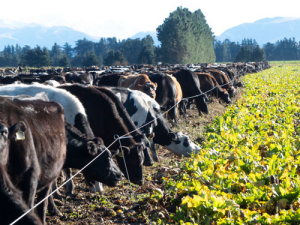TB slaughter levy for dairy jumps 75c/head
TB differential slaughter levy rates are changing with dairy animals paying $12.25/head, an increase of 75c from next month.
 Leaving critical source areas (CSAs) in winter forage paddocks ungrazed over winter helps prevent soil losses and water contamination.
Leaving critical source areas (CSAs) in winter forage paddocks ungrazed over winter helps prevent soil losses and water contamination.
Farmers are being reminded of the importance of leaving critical source areas in winter forage paddocks ungrazed over winter to prevent soil losses and water contamination.
Beef+Lamb New Zealand's Jane Chrystal says the interim results of a Landcare Trust/AgResearch study 'Understanding the impacts of sheep wintering' reinforced the value of leaving critical source areas (CSAs) ungrazed. The CSAs help trap and retain sediment and contaminant run-off resulting from winter grazing.
Under good practice winter grazing management, CSAs - which are low-lying areas within a paddock such as depressions, gullies and swales - should be fenced off and left ungrazed until spring or summer. Ideally, these areas should be left in grass, which acts as an ideal filter and sediment trap.
Chrystal - B+LNZ's principal science advisor, farm systems & environment - says early results from the trial comparing contaminant loss and sediment trapped on similar paddocks, one where the CSAs were grazed while the other was ungrazed, were consistent and significant.
While both paddocks were sown in kale and under a similar management regime of top-down grazing and two breaks of five days, there was a marked difference in the amount of suspended sediment in the water samples collected from each paddock after rainfall events.
Even before analysing the suspended sediment data, the scientists found visually striking evidence of the immediate effectiveness of the CSA on reducing the loss of soils from the paddocks.
The report states that "these visually striking differences provided an immediate indicator that the CSA was having a demonstrable impact on retaining soil and sediments eroded from the uphill portions of the paddock".
Subsequent analysis of the suspended sediments from all rainfall events throughout the winter of 2021 supported these results.
Chrystal explains that the trial, which started in the winter of 2020, is being run on a commercial farm in Waitahuna, West Otago. The goal is understanding the impacts of winter sheep grazing management on several environmental indicators.
"These results highlight the importance of keeping stock away from CSAs during winte and valuing these areas for their ability to prevent soil and contaminant losses."
She encourages all farmers growing winter forage crops to work through the Forage Cropping Management Plan, which is a chapter in B+LNZ's Farm Plan or available as a stand-alone resource.
"This plan will help farmers identify their risks and plan how they will make the best use of their winter feed resources, while protecting their environment and animal welfare."
Canterbury farmer Michelle Pye has been elected to Fonterra’s board for a three-year term.
Farmers are welcoming the announcement of two new bills to replace the under-fire Resource Management Act.
The Government has announced it will immediately roll over all resource consents for two years, with legislation expected to pass under urgency as early as this week.
The New Zealand National Fieldays Society has achieved a major sustainability milestone - reducing its greenhouse gas emissions and reaching the target five years early.
Fonterra's 2025/26 financial year is off to a strong start, with a first quarter group profit after tax of $278 million- up $15m on the previous year.
Government plans to get rid of regional councillors shows a lack of understanding of the fundamental problem affecting all of local government - poor governance.

OPINION: Your old mate welcomes the proposed changes to local government but notes it drew responses that ranged from the reasonable…
OPINION: A press release from the oxygen thieves running the hot air symposium on climate change, known as COP30, grabbed your…